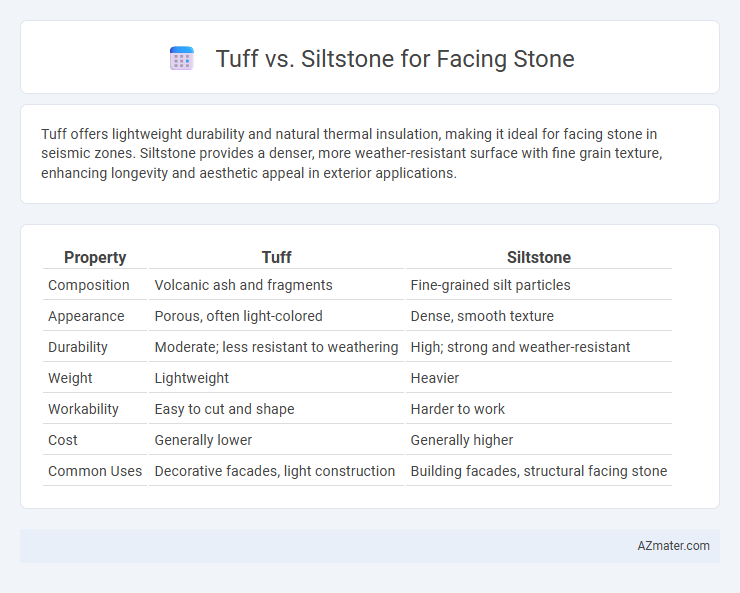Tuff offers lightweight durability and natural thermal insulation, making it ideal for facing stone in seismic zones. Siltstone provides a denser, more weather-resistant surface with fine grain texture, enhancing longevity and aesthetic appeal in exterior applications.
Table of Comparison
| Property | Tuff | Siltstone |
|---|---|---|
| Composition | Volcanic ash and fragments | Fine-grained silt particles |
| Appearance | Porous, often light-colored | Dense, smooth texture |
| Durability | Moderate; less resistant to weathering | High; strong and weather-resistant |
| Weight | Lightweight | Heavier |
| Workability | Easy to cut and shape | Harder to work |
| Cost | Generally lower | Generally higher |
| Common Uses | Decorative facades, light construction | Building facades, structural facing stone |
Introduction to Facing Stone Materials
Tuff and siltstone are common choices for facing stone in construction due to their distinct geological properties and aesthetic appeal. Tuff, a porous volcanic rock, offers lightweight durability and workability, making it ideal for exterior cladding and decorative facades. Siltstone, a fine-grained sedimentary rock, provides a dense, hard surface with subtle color variations, which enhances structural stability and architectural elegance in building exteriors.
What is Tuff? Key Properties and Formation
Tuff is a volcanic rock formed from the consolidation of volcanic ash ejected during explosive eruptions, characterized by its lightweight and porous nature. Key properties of tuff include its relatively low density, high porosity, excellent thermal insulation, and ease of quarrying, making it suitable for facing stone applications. Its formation involves the rapid cooling and cementation of volcanic ash, often incorporating fragments of other rocks and minerals, contributing to its varied texture and durability.
What is Siltstone? Key Properties and Formation
Siltstone is a fine-grained sedimentary rock composed primarily of silt-sized particles, typically ranging from 0.0039 to 0.0625 mm in diameter, formed through the lithification of silt deposited by water or wind. Key properties include its moderate hardness, low porosity, and often smooth, dense texture, making it suitable for facing stone applications where durability and aesthetic appeal are important. The formation of siltstone involves the compaction and cementation of silt-rich sediments in low-energy environments such as river deltas, floodplains, and quiet marine settings.
Tuff vs Siltstone: Appearance and Texture
Tuff exhibits a porous, lightweight texture with a rough, irregular surface that often features visible volcanic ash particles, giving it a distinctive, natural appearance suitable for rustic or rugged architectural designs. Siltstone, on the other hand, has a finer-grained, smoother texture with a more uniform and compact appearance, often presenting subtle color variations ranging from tan to gray. The choice between tuff and siltstone for facing stone depends on aesthetic preferences, with tuff offering a more textured, volcanic look and siltstone providing a sleeker, more polished surface finish.
Durability and Weather Resistance Comparison
Tuff exhibits moderate durability and weather resistance due to its porous volcanic origin, making it more susceptible to erosion and moisture damage compared to the denser siltstone. Siltstone offers superior durability and weather resistance with its fine-grained, compact structure that withstands freeze-thaw cycles and chemical weathering more effectively. For facing stone applications requiring long-term resilience, siltstone is often preferred over tuff because of its enhanced structural stability and lower porosity.
Workability and Installation Differences
Tuff offers superior workability compared to siltstone due to its softer, more porous nature which allows easier cutting and shaping for facing stone applications. Siltstone, being denser and harder, requires more specialized tools and effort during installation, resulting in longer labor times and higher costs. The choice between tuff and siltstone significantly impacts installation efficiency, with tuff enabling faster application and reduced labor intensity on construction projects.
Cost Analysis: Tuff vs Siltstone
Tuff typically offers a lower cost option compared to siltstone, largely due to its abundance and easier quarrying processes. Siltstone, being denser and often exhibiting more desirable aesthetic qualities, commands higher prices reflecting both material and finishing expenses. Cost analysis must also consider long-term durability and maintenance, where siltstone may provide better value despite higher initial investment.
Environmental Impact and Sustainability
Tuff, a volcanic rock, is often favored over siltstone for facing stone due to its lower environmental impact, as it requires less energy-intensive extraction and processing. Siltstone quarrying typically disrupts ecosystems more significantly and consumes more water and energy, increasing its carbon footprint. The porous nature of tuff also enhances insulation, contributing to building sustainability by reducing energy demand for heating and cooling.
Best Applications for Tuff and Siltstone as Facing Stones
Tuff, characterized by its lightweight and porous structure, is ideal for decorative facing stone applications where ease of installation and natural aesthetic appeal are prioritized, such as cladding residential facades and garden walls. Siltstone offers superior durability and weather resistance, making it suitable for high-traffic exterior walls, commercial buildings, and historic restorations requiring long-lasting and low-maintenance stone facades. Both materials provide unique textures and colors, but tuff excels in softer, ornamental uses while siltstone is preferred for rugged, structural facing stone applications.
Conclusion: Choosing the Right Stone for Your Project
Tuff offers lightweight durability and ease of carving, making it ideal for detailed architectural facing stones, while siltstone provides superior hardness and weather resistance suited for long-lasting exterior cladding. Selecting the right stone depends on project requirements such as structural load, aesthetic preference, and environmental exposure. Understanding the specific geological properties and performance characteristics of tuff and siltstone ensures optimal material choice for both visual appeal and longevity in facing stone applications.

Infographic: Tuff vs Siltstone for Facing Stone
 azmater.com
azmater.com